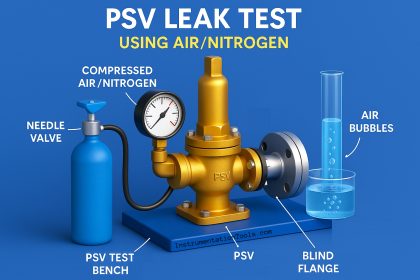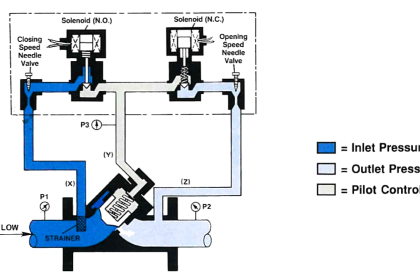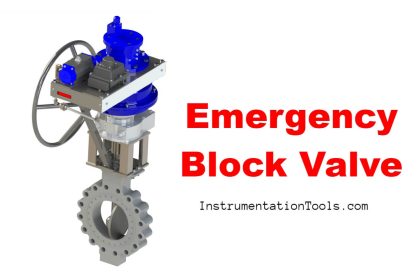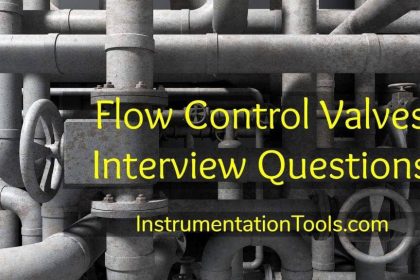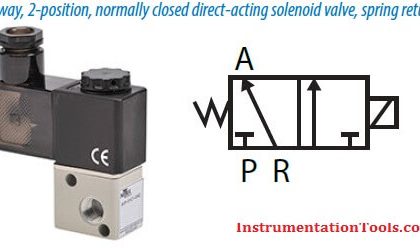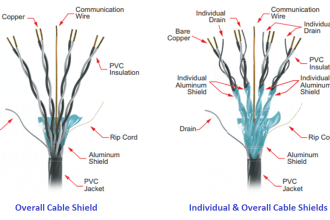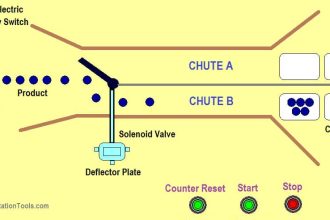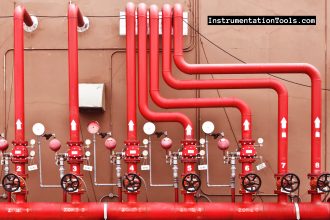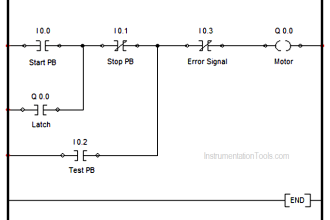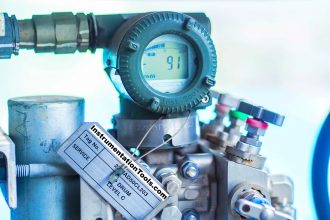We provide you the latest 100 MCQ questions and answers on the valves used in the refineries, Oil and gas, and power plants.
Valve MCQ
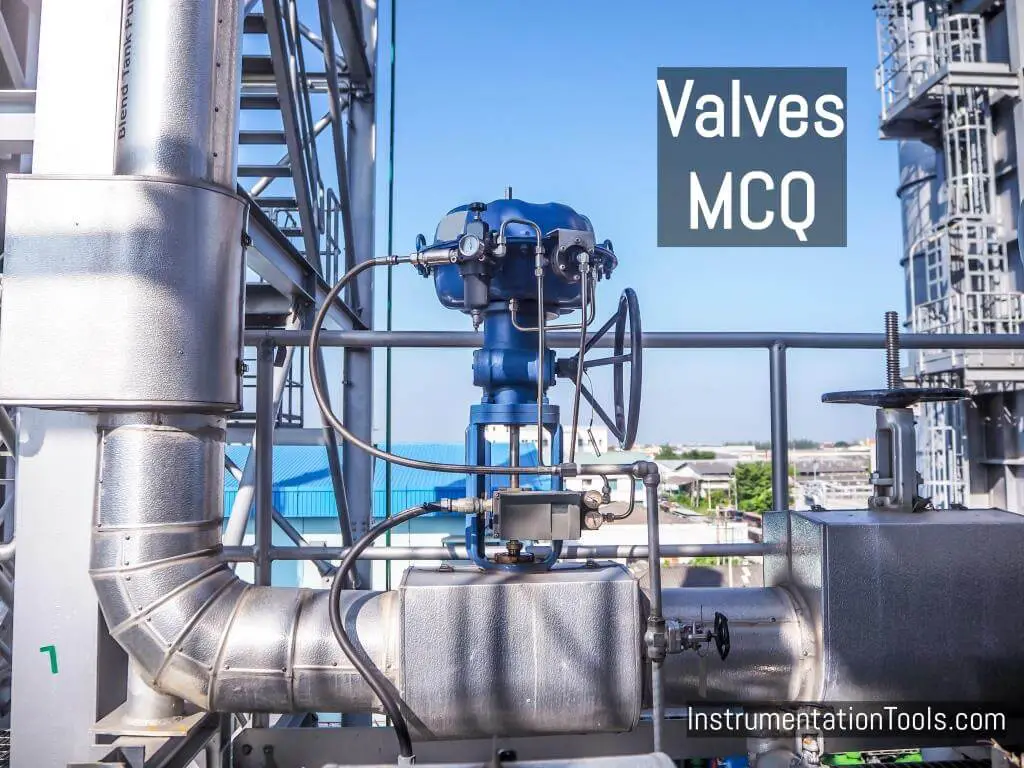
Find the sample 25 questions from the valves MCQ. Click on the below start button to get complete 100+ questions with answers.
Question 1:
A control valve is most likely to experience cavitation when the valve is almost fully __________ because of a relatively __________ pressure drop across the valve seat.
A) closed; large
B) open; large
C) open; small
D) closed; small
Question 2:
After an adjustment of the packing gland on a valve that had a minor packing leak, an operator attempts to operate the valve but finds the valve is stuck.
What is the most probable cause?
A) The valve was over-torqued in the closed direction during the packing gland adjustment.
B) The operator placed the valve in the wrong position for adjusting the packing gland.
C) The maintenance technician overtightened the packing gland, causing the stem to bind.
D) The disk separated from the valve stem as a result of overtightening the packing gland.
Question 3:
Check valves are normally used to prevent…
A) pump cavitation by keeping nonoperating systems filled.
B) pump runout by providing a constant backpressure.
C) overpressurization of nonoperating system piping and components.
D) backflow through nonoperating components or flowpaths.
Question 4:
Which one of the following is a difference between a typical relief valve and a typical safety valve?
A) Relief valves are capable of being gagged whereas safety valves are not.
B) A relief valve gradually opens as pressure increases above the setpoint pressure whereas a safety valve pops open at the setpoint pressure.
C) The blowdown of a relief valve is greater than the blowdown of a safety valve.
D) The actuator closing spring on a relief valve is in a compressed state whereas the actuator closing spring on a safety valve acts in tension.
Question 5:
Which one of the following is the type of valve used to control the direction of fluid flow through a system and prevent backflow?
A) Gate valve
B) Butterfly valve
C) Globe valve
D) Check valve
Question 6:
A typical motor-operated valve (MOV) has just been opened from the main control room, and the breaker for the MOV has been opened.
A plant operator has been directed to close the MOV locally for a surveillance test.
If the operator attempts to turn the MOV handwheel in the clockwise direction without first operating the declutch lever, which one of the following will occur?
A) The handwheel will not turn, and the valve stem will not move.
B) The handwheel will turn, and the valve stem will move toward the closed position because the clutch is automatically engaged when the breaker is opened.
C) The handwheel will turn, and the valve stem will move toward the closed position because the clutch is automatically engaged when the handwheel is turned.
D) The handwheel will turn, but the valve stem will not move.
Question 7:
In a comparison between ball valves and butterfly valves in the same water system application, the valve that would typically be more leak-tight when fully closed with a high differential pressure is the __________ valve;
& the valve that typically results in the greater pressure decrease when fully open is the __________ valve.
A) butterfly; ball
B) butterfly; butterfly
C) ball; butterfly
D) ball; ball
Question 8:
Consider a 6-inch globe valve and a 6-inch gate valve in the same water system application.
Typically, the valve that requires the most linear disk travel from fully closed to fully open is the __________ valve; and the valve that produces the smallest pressure drop when fully open is the __________ valve.
A) globe; globe
B) globe; gate
C) gate; gate
D) gate; globe
Question 9:
In a comparison between gate valves and globe valves in the same water system application, gate valves…
A) produce a larger pressure decrease when fully open.
B) require more force to open against large differential pressures.
C) are more effective at throttling flow.
D) are more effective as pressure regulating valves.
Question 10:
Which one of the following types of similarly sized valves requires the most manual valve stem rotation to move the valve from fully open to fully closed?
(Assume that each valve has a non-rising stem.)
A) Plug
B) Gate
C) Butterfly
D) Ball
Question 11:
The primary purpose of a pressure relief valve is to…
A) maintain system integrity.
B) reduce system pressure.
C) reduce system energy.
D) maintain system mass.
Question 12:
An operator attempts to close a fully-open upright manual gate valve to isolate a pump in a cooling water system that has been cooled down for maintenance.
However, the operator is unable to rotate the handwheel in the close direction.
Which one of the following could cause this condition?
A) The two halves of the valve disk have expanded and are jammed against the valve seats.
B) A hydraulic lock has developed under the valve disk.
C) A hydraulic lock has developed in the valve bonnet between the valve disk and the packing gland.
D) The valve disk has jammed against its backseat by the difference in the thermal contraction of the stem and the bonnet.
Question 13:
A stop check valve is a type of check valve that…
A) cannot be shut remotely.
B) can be used to prevent flow in both directions.
C) contains both a gate valve disk and a check valve disk.
D) can be opened manually to allow flow in both directions.
Question 14:
Consider a typical gate valve and a typical globe valve in the same water system application.
The globe valve generally has a __________ pressure drop when fully open; and is __________ commonly used for throttling system flow.
A) larger; less
B) larger; more
C) smaller; more
D) smaller; less
Question 15:
During a local inspection of a manually operated 12-inch gate valve, the valve stem is observed to extend outward from the valve handwheel by 1 inch.
The entire external valve stem is threaded, except for a 1-inch section that becomes smooth just before the valve stem enters the packing gland.
Which one of the following describes the position of the gate valve?
A) The valve may be in any position because it is a non-rising stem gate valve.
B) The valve is fully open or nearly fully open.
C) The valve may be in any position because it is a rising stem gate valve.
D) The valve is fully closed or nearly fully closed.
Question 16:
Which one of the following describes the function and use of the backseat on a manual valve?
A) Acts as a backup in case the primary seat leaks and is typically used when needed to prevent the primary seat from leaking excessively.
B) Acts as a backup in case the primary seat leaks and is typically used during system isolation for personnel protection.
C) Removes pressure from the packing/stuffing box and is typically used when needed to isolate packing leakage.
D) Removes pressure from the packing/stuffing box and is typically used to isolate the stuffing box for valve repacking.
Question 17:
A gate valve is generally a poor choice for throttling fluid flow because…
A) excessive stem leakage will result unless the gate valve is fully open or fully closed.
B) the head loss from a throttled gate valve will result in an unacceptable reduction in system flow rate.
C) the tortuous path through a gate valve body can make flow control difficult.
D) the turbulent flow created by a partially opened gate valve can cause extensive damage to the valve.
Question 18:
The difference between the setpoint pressure at which a safety valve opens and the pressure at which it closes is called…
A) accumulation.
B) blowdown.
C) setpoint tolerance.
D) setpoint deviation.
Question 19:
Which one of the following types of similarly sized valves in an operating water system produces the least frictional head loss when fully open?
A) Butterfly
B) Swing check
C) Globe
D) Ball
Question 20:
How will a typical motor-operated valve respond to a loss of electrical power to the valve actuator?
A) Open fully
B) Remain as is
C) Move to 50 percent open
D) Close fully
Question 21:
Which one of the following is not a generally accepted method for locally verifying that a valve is open?
A) Attempt to turn the valve operator in the open direction and verify that no movement occurs.
B) Observe local flow rate instrumentation.
C) Check the local valve position indicator indicates OPEN.
D) Turn the valve operator in the close direction and verify that some movement occurs.
Question 22:
A main steam system uses a combination of safety and relief valves for overpressure protection.
Which one of the following describes a major design consideration for installing both types of valves in the same system?
A) The relief valves are installed to prevent unnecessary opening of the safety valves during a steam pressure transient.
B) The relief valves are installed to prevent chattering of the safety valves during normal power operation.
C) The safety valves are installed to prevent unnecessary opening of the relief valves during a steam pressure transient.
D) The safety valves are installed to prevent chattering of the relief valves during normal power operation.
Question 23:
Which one of the following statements describes the throttling characteristics of a typical globe valve?
A) The first two-thirds of valve disk travel in the open direction will produce approximately the same increase in flow rate as the last third of valve disk travel.
B) The first third of valve disk travel in the open direction will produce a greater increase in flow rate than the last third of valve disk travel.
C) The first third of valve disk travel in the open direction will result in approximately one-third of full flow rate.
D) The first third of valve disk travel in the open direction will produce a smaller increase in flow rate than the last third of valve disk travel.
Question 24:
Which one of the following describes the function of a safety valve?
A) Modulate open as necessary to maintain system pressure and/or temperature within normal limits.
B) Provide overpressure protection to limit the internal pressure in vessels.
C) Sound a warning by lifting at a predetermined value slightly higher than operating pressure.
D) Control pressure in a system to maintain optimum operational conditions.
Question 25:
A typical motor-operated valve has been returned to service following a complete maintenance overhaul of the valve and actuator.
When the valve was remotely opened and closed to verify operability, the measured valve stroke time in each direction was 15 seconds, which is shorter than normal for this valve.
Which one of the following could have caused the shorter stroke time?
A) The valve position limit switches were removed and were not reinstalled.
B) The valve torque limit switches were misadjusted to open at twice their normal setpoints.
C) The valve stem packing gland was overtightened after the packing material was replaced.
D) The valve was packed with improved packing material having a lower friction coefficient.
Click on the below button to launch the Quiz.
Answers available in the Quiz.
Share your feedback on the quiz
Next Quizzes:
- PLC Questions & Answers
- Industrial Instrumentation Quiz
- Measurements & Instrumentation
- Process Control Test Questions
- Top 100 Instruments Quiz

